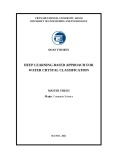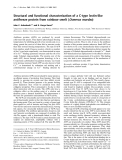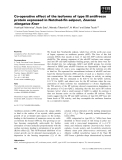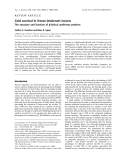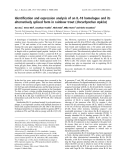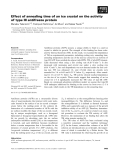
Ice crystals
-
Depending on the origin of the water and the formation process, crystals are divided into three main types: snow crystals, ice crystals, and water crystals. From the shape of the crystal, the purity and the texture level are clearly reflected, then it enables us to assess the quality of the water.
 63p
63p  mudbound
mudbound
 10-12-2021
10-12-2021
 19
19
 4
4
 Download
Download
-
Antifreeze proteins (AFPs) are produced by several cold-water fish species. They depress physiological freezing temperatures by inhibiting growth of ice crystals and, in so doing, permit the survival of these fish in seawater cooler than their normal freezing temperatures. The type II AFP from rainbow smelt (Osmerus mordax), which is a member of the C-type lectin superfamily, was characterized in terms of its Ca2+-binding quaternary structure and the role of its single N-linked oligosaccharide....
 8p
8p  research12
research12
 01-06-2013
01-06-2013
 41
41
 4
4
 Download
Download
-
We found that Notched-fin eelpout, which lives off the north east coast of Japan, expresses an antifreeze protein (AFP). The liver of this fish contains DNAs that encode at least 13 type III AFP isoforms (denoted nfeAFPs). The primary sequences of the nfeAFP isoforms were categor-ized into SP- and QAE-sephadex binding groups, and the latter were fur-ther divided into two subgroups, QAE1 and QAE2 groups. Ice crystals observed in HPLC-pure nfeAFP fractions are bipyramidal in shape with different ratios ofc andaaxes, suggesting that all the isoforms are able to bind ice....
 11p
11p  awards
awards
 05-04-2013
05-04-2013
 45
45
 3
3
 Download
Download
-
Antifreeze proteins (AFPs) designate a class of proteins that are able tobind toand inhibit the growthofmacromolecular ice. These proteins have been characterized froma variety of organisms. Recently, the structures ofAFPs fromthe spruce budworm (Choristoneura fumiferana) and the yellow meal-worm (Tenebrio molitor) have been determined by NMR and X-ray crystallography. Despite nonhomologous sequences, both proteins were shown to consist ofb-helices.
 12p
12p  awards
awards
 05-04-2013
05-04-2013
 45
45
 5
5
 Download
Download
-
A homologue of interleukin 18 has been identified from rainbow trout,Oncorhynchus mykiss. The trout IL-18gene spans 3.7 kb and consists of six exons and five introns, sharing the same gene organization with its human coun-terpart. The putative translated protein is 199 amino acids in length with no predicted signal peptide. Analysis of the multiple sequence alignment reveals a conserved ICE cut site, resulting in a mature peptide of 162 amino acids. The trout IL-18 shares 41–45% similarity with known IL-18 molecules and contains an IL-1 family signature motif....
 11p
11p  dell39
dell39
 03-04-2013
03-04-2013
 54
54
 3
3
 Download
Download
-
Antifreeze proteins (AFPs) possess a unique ability to bind to a seed ice crystal to inhibit its growth. The strength of this binding has been evalu-ated by thermal hysteresis (TH). In this study, we examined the dependence of TH on experimental parameters, including cooling rate, annealing time, annealing temperature and the size of the seed ice crystal for an isoform of type III AFP from notched-fin eelpout (nfeAFP8).
 8p
8p  media19
media19
 05-03-2013
05-03-2013
 50
50
 2
2
 Download
Download
CHỦ ĐỀ BẠN MUỐN TÌM









